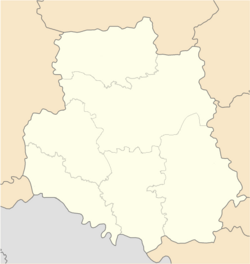Vapniarka
Vapniarka
Вапнярка | |
|---|---|
Location in Vinnytsia Oblast Location in Ukraine | |
| Coordinates: 48°32′N 28°45′E / 48.533°N 28.750°E | |
| Country | |
| Oblast | |
| Raion | Tulchyn Raion |
| Hromada | Vapniarka territorial communities |
| Founded | 1870 |
| Area | |
• Total | 13 km2 (5 sq mi) |
| Population (2022) | |
• Total | 7,165 |
| • Density | 550/km2 (1,400/sq mi) |
| Postal code | 24240—244 |
| Area code | +380 4350 |
Vapniarka (Ukrainian: Вапнярка), also known as Vapniarca, Vapnyarka, Wapnjarka or Wapniarka, is a rural settlement in Tulchyn Raion, Vinnytsia Oblast, Ukraine, known since 1870 as a railroad station. Its name from the Ukrainian language translates as a lime (gypsum) settlement. As of January 2022 Vapniarka's population was approximately 7,165.[1]
History
[edit]During World War II, following the start of Operation Barbarossa, Vapniarka was administered by Romania. From October 22, 1941, to March 1944, it was included in the region of Transnistria and became the site for a concentration camp for members of the Romanian Jewish community. This succession of events formed a part of The Holocaust in Romania.
Today, Vapniarka serves as the final train destination for visitors traveling to villages in Tomashpilskyi and Yampilskyi Raion of Vinnytsia Oblast. From here, buses or private transportation are used to get to villages like Busha, Dzyhivka, Olhopil, Tomashpil, and Sobolivka.
Until 26 January 2024, Vapniarka was designated urban-type settlement. On this day, a new law entered into force which abolished this status, and Vapniarka became a rural settlement.[2]
World War II camp
[edit]In October 1941, the Romanians established a detention camp in Vapniarka. One thousand Jews were brought to the site that month, mostly from the city of Odessa. Some 200 died in a typhus epidemic; the others were taken out of the camp in two batches, guarded by soldiers of the Romanian Gendarmerie, and shot to death.[3]
References
[edit]- ^ Чисельність наявного населення України на 1 січня 2022 [Number of Present Population of Ukraine, as of January 1, 2022] (PDF) (in Ukrainian and English). Kyiv: State Statistics Service of Ukraine. Archived (PDF) from the original on 4 July 2022.
- ^ "Что изменится в Украине с 1 января". glavnoe.in.ua (in Russian). 1 January 2024.
- ^ Kessler, Arthur (2024). Spitzer, Leo (ed.). A Doctor's Memoir of the Romanian Holocaust: Survival in Lager Vapniarka and the Ghettos of Transnistria. Rochester Studies in East and Central Europe. Translated by Robinson, Margaret. Rochester NY: University of Rochester Press. ISBN 978-1-64825-093-4.
External links
[edit]- The Vapniarka camp The Holocaust in Romania, Friedrich-Ebert-Stiftung and Elie Wiesel National Institute for Studying the Holocaust in Romania
- Nizkor Project Archived 2007-06-13 at the Wayback Machine Tesimony of a camp inmate
- Shoah Resource Center - Yad Vashem Personal artifacts from camp inmates, including Vapniarka
- Local site in Ukrainian about modern Vapniarka [1]




